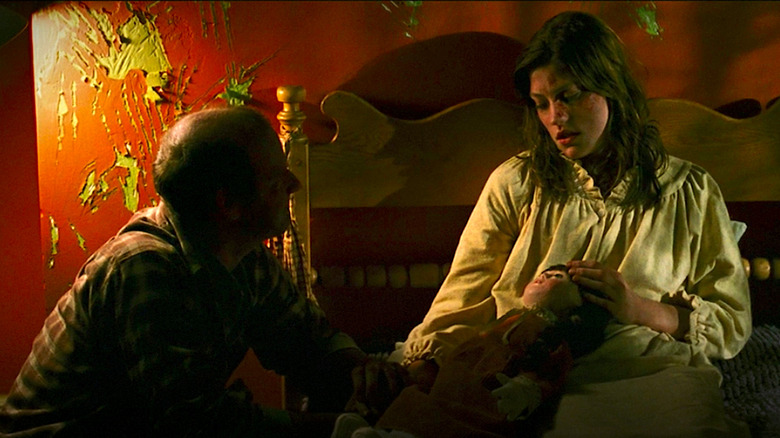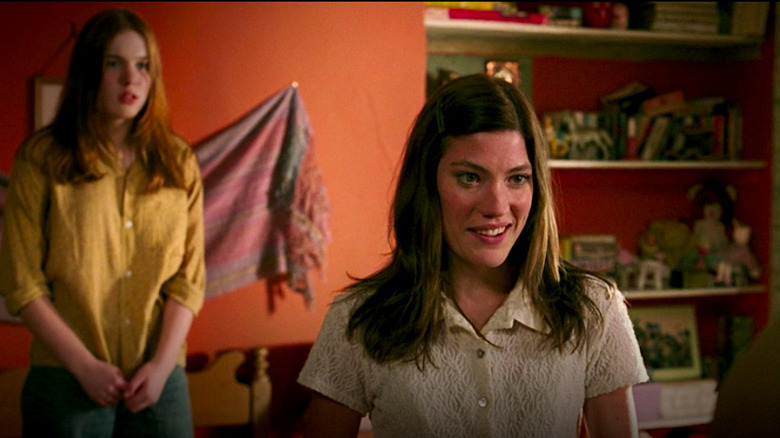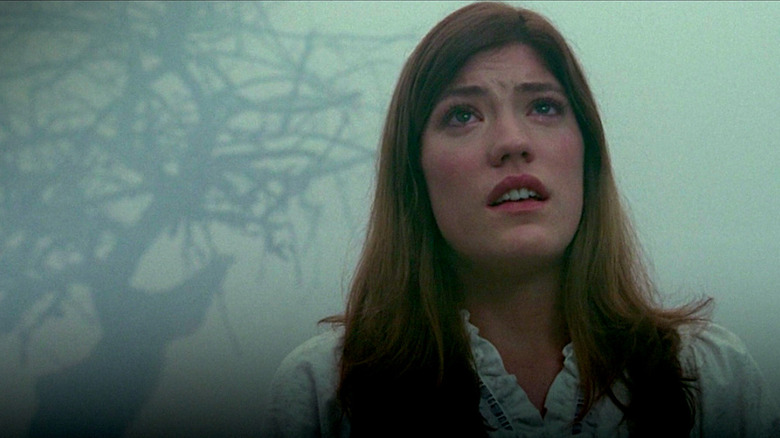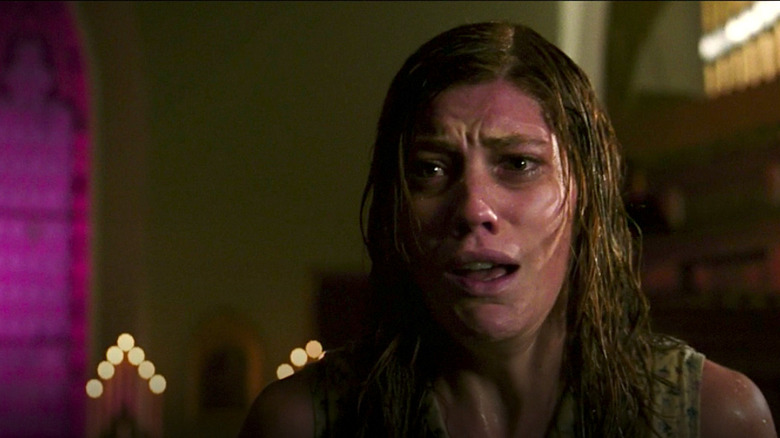The Tragic Real-Life Story Behind The Exorcism Of Emily Rose
Horror movies are notorious for often basing their stories on real-life events. Famous horror films like "The Texas Chain Saw Massacre" and "The Conjuring" have taken some of their most terrifying details from things that actually happened to real people. And one of the scariest horror flicks allegedly based on a true story is Scott Derrickson's "The Exorcism of Emily Rose." The film is based on the real-life story of Anneliese Michel, a German woman who was believed to be possessed by the Devil and underwent multiple exorcisms to try to get rid of the demon. She, like the fictional Emily Rose, eventually died — and her family and the priests who performed her exorcisms were put on trial for negligent homicide.
In the movie adaptation of this tragic event, defense lawyer Erin Bruner (Laura Linney) takes on Father Richard Moore's (Tom Wilkinson) case, arguing that the priest is not at fault for Emily's (Jennifer Carpenter) tragic death. The prosecuting attorney, Ethan Thomas (Campbell Scott), is trying to prove that Father Moore prevented Emily from being treated for epilepsy and schizophrenia — which resulted in her death. Viewers learn of Emily's story through flashbacks that show what happened to the young woman before she died. The movie is unique in its blending of trial drama and horror, and it's mighty effective in its visceral flashbacks of Emily's final days. In the end, Moore is found guilty by the jury. However, they request that his sentence only be for the time he's already served while waiting for the trial to conclude. He is allowed to leave the courtroom as a guilty, but free, man.
"The Exorcism of Emily Rose" is a compelling horror film because of the way it takes on difficult topics like science and religion. The actual life story of Anneliese Michel differs from the film's depiction of Emily Rose, and to understand both the tragedy of her life and the film's power, it's important to reflect on what really happened.
The Real Emily Rose
Anneliese Michel was born in 1952 in Bavaria. Raised by a devoutly Roman Catholic family, she began to experience seizures at the age of 16. She was eventually diagnosed with epilepsy and put on various medications to help control the convulsions. However, the medications didn't seem to curb her increasingly erratic behavior, and her family began to look for help outside of the traditional medical field.
As her symptoms worsened, she developed an extreme aversion to anything symbolic of Christianity. She also reported seeing demonic faces and hearing demons talking to her. An article for Grunge reports that Michel began "compulsively doing hundreds of squats and genuflections a day — 400 to 600 by most accounts — until she eventually ruptured the ligaments in her knees." She also reportedly screamed incessantly and began to eat bugs, behaviors that were not abated by the use of doctor-prescribed medications. Reports vary on whose idea it was to perform an exorcism — some say Michel demanded it, others say it was a decision made by both her and her parents — but eventually, the family enlisted the help of a priest named Ernst Alst. Along with Pastor Arnold Renz, the two men set about exorcising Michel from her demons.
Anneliese Michel would eventually endure 67 separate exorcisms in her final days. During these intense periods, the Washington Post reports that she would often name the demons that possessed her, "and [she] even answered the exorcists' questions, explaining what was wrong with the church or why they were in Hell." Video recordings exist of these chilling conversations that Anneliese Michell had with Alst and Renz, and listening to them is both disturbing and heartbreaking.
Ultimately, Anneliese Michel passed away after enduring almost a year of multiple weekly exorcisms. Towards the end of her life, she refused to eat — which only sped up her worsening physical condition. When she died, she weighed less than 70 pounds, and her cause of death was reported as "malnutrition and dehydration that resulted from almost a year of semi-starvation during the rites" as reported by the Washington Post. Her parents, along with Alst and Renz, were put on trial for negligent homicide, and they were ultimately found guilty of negligent manslaughter and sentenced to "six-month prison sentences, which were suspended, and three years' probation."
Emily vs. Anneliese
"The Exorcism of Emily Rose" does a decent job of portraying Anneliese Michel's tragic story. However, like all movies based on real events, some changes have been made. One of the most obvious is that Emily Rose isn't German but American. That being said, there are moments where the movie nods to the original nationality of Anneliese Michel. During the scene depicting Emily's exorcism, Emily begins speaking in German, a moment that harkens back to the actual tapes of Anneliese Michel fervently talking to Alst and Renz. If you're unfamiliar with the source material, you might miss this subtle nod, but it is a nice addition for those familiar with Michel's backstory.
It's also important to note that the only person on trial in "The Exorcism of Emily Rose" is the priest himself, Father Richard Moore. Emily's family has avoided sentencing in the death of their child, and Father Moore is the only one being charged with the same sentence as the real-life case of negligent homicide. The decision to avoid placing Emily's parents on trial along with Father Moore goes a long way toward highlighting the religious significance of Emily's death. Without her parents on trial, the case truly becomes solely about religious belief vs. scientific belief, making the outcome of the movie all the more impactful.
There are other smaller details that have been changed in the movie, like the fact that Emily is only 19 years old at the time of her death, and only one exorcism is ever performed on her (in reality, Anneliese Michel was 23 when she died, and as stated earlier, she underwent nearly 70 separate exorcisms). But the biggest difference between the film and the real story is the sentencing of Father Moore. During the real trial, the prosecution suggested that the only punishment for the priests and for the parents come in the form of a guilty verdict and monetary fines. However, this wish was not reflected in the real outcome. In the film, though, Father Moore is found guilty, but the jury requests his punishment be time served — meaning that he is free to go. This change in sentencing suggests that everyone had a role to play in the death of Emily Rose — or Anneliese Michel, depending on how you want to read it — and everyone hopes their own chosen belief systems could ultimately save her.
How The Exorcism of Emily Rose Goes Beyond a Good Scare
When you sign on to watch a horror movie, you expect to be scared. Maybe you'll jump a little in your seat, maybe you'll find yourself grossed out at the gore. But if a horror movie fails to add any real suspense into the mix, it can often backfire. So what happens when you take a very real, very tragic story and try to adapt it into a horror movie? Well, one of two things can occur. You can either have a film that focuses solely on shock and scares but ultimately ends up devaluing — and possibly even disrespecting — the story's source material, or you can have a film that tries to tastefully straddle the line between its commitment to the horror genre and to remaining respectful to the original story.
In the case of "The Exorcism of Emily Rose," while not 100% successful, it is definitely a film that strives to achieve the latter effect. Because much of the movie is set in court, the film resists the urge to play into the dark and twisted psychology (and potential gore) of possession. Instead, the only times the audience is privy to the more intense aspects of Emily's condition are during flashbacks that are often prompted by another character recounting their memory of Emily. This means that the scarier parts of the film are few and far between, and when they do happen, they almost always serve a purpose. Rarely are there any gratuitous shows of gore and violence that feel unnecessary or out of place. Anneliese Michel's story is allowed to exist on screen in a way that seeks to shine a light rather than exploit.
In fact, the film's main argument seems to have less to do with objectifying the suffering of Emily, and more to do with drawing attention to the distinction between religious and scientific belief. If a person believes the practices of their religion will save them even if they ultimately end up doing more harm than good, does that constitute neglect? In the current social climate where personal belief is a hot-button issue, this is a question worth ruminating upon. Whether you believe Emily/Anneliese was truly the subject of possession, her story remains one worthy of telling.



